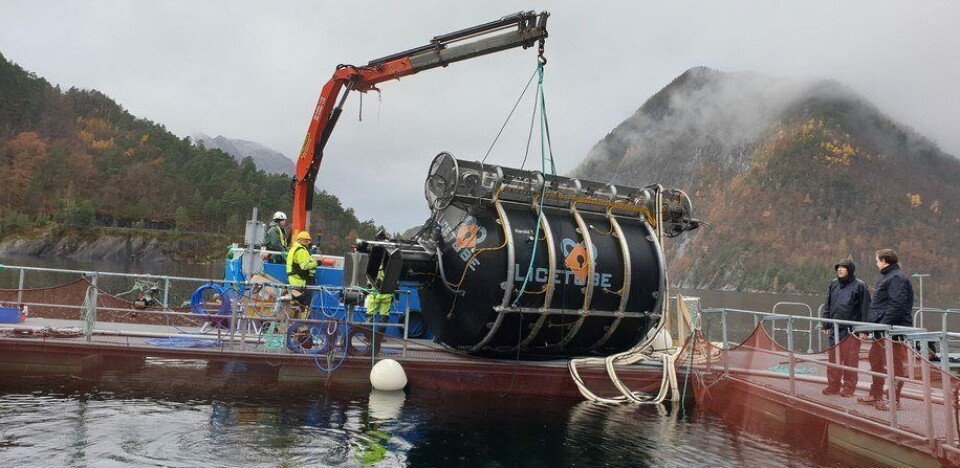
LiceTube ready for sale ‘within one or two years’
A revolutionary in-cage de-lousing system that lures salmon through a treatment tube using a counter-current and lights could be available commercially available within 12-24 months, its inventor has predicted.
Tests in Norway on a full-scale version of the LiceTube have proved its technology successfully draws fish into the tube, and then into an antechamber for treatment.
The testing was performed by developer CLT Solutions AS, in collaboration with subcontractors, in cages rented from the Marine Research Institute (HI) at its marine research station at Matre, around 50 miles north of Bergen.

Continuous fish flow
The big question was whether the LiceTube could manage to attract enough fish continuously and move them to the treatment chamber, day and night. It has done that.
LiceTube inventor and CLT general manager Henry Helgheim told Fish Farming Expert’s Norwegian sister site, Kyst.no, that now is the time to find a relevant company that can take the commercialisation of the LiceTube forward.
“We are convinced that we will achieve our goal, namely that the fish health station LiceTube will be the preferred product in the fight against salmon lice, and better fish health. Which in turn makes it more profitable for farmers, and opens things up for the industry to grow,” he said.
Great interest
The inventor says there has been great interest in the LiceTube, both in Norway and abroad.
“Then came the coronavirus and it changed quite a lot. It was a bit quiet, but some time passed in the coronavirus period, and the status today is that we have contact with a number of stakeholders.”
The company now has a handful of companies that can take the LiceTube a step further, said Helgheim.

Third-party tests
He added that the company will now perform a new test of the de-lousing unit at HI’s research facility in Austevoll. HI will be responsible for the testing, so that it is verified by an independent and credible third party.
Helgheim says the company is certain that the technique works and is effective.
“We saw this in the experiment in rented cages at HI on Matre. But in order for this to be done according to the textbook, it must be done again, by an approved research station, therefore we will let HI Austevoll be responsible for the experiment this time,” he explained.
De-lousing method
The LiceTube’s developers have not yet decided which de-lousing method will be used.
“We have a few different alternatives that we are strongly considering using, but we will get everything else verified and tested first. Then we have to choose de-lousing technology in relation to the number of fish that go through,” said Helgheim.
The inventor says the company has abandoned the idea that the LiceTube should be a pure de-lousing unit, but rather that it should function as a health station for the fish.
“We will not only focus on de-lousing, but also sexual maturation, growth, and other parameters.”

Zero mortality
Helgheim believes one of the advantages of the LiceTube is that the unit is placed in the cage with the fish, and de-lousing and measurements therefore take place on the fish’s premises.
“The goal is for the mortality rate when using LiceTube to be zero,” says Helgheim, who said he hopes the device will be commercially available within 12-24 months.
“Even though we feel confident that this works as we had anticipated, we will have to keep the possibility open that there will also be challenges on the ‘run-up’ side.”
Optimised lighting
The LiceTube works by using a combination of counter-current and light.
“The experiments have given us a rich experience of which lights work best. It has been wonderfully fascinating to see how the fish react to the different colours in the light. The use of lighting is now optimised in relation to the experience material one has.”
In the long run, Helgheim envisages that AI (artificial intelligence) will be able to further improve this. It will then be possible to capture any tendencies for the fish to “get bored” and thus change the lighting composition so that it is always optimal in relation to the season, depth and other relevant factors.
Analysed and treated
Inside the tube, one fish at a time is led into a smaller tube, where it is dazzled with special light so that it is paralysed and remains still while it is scanned and analysed. Here, the system will be able to get lots of information about the fish, from length and weight to injuries and deformities and whether the fish has lice, which will be detected quickly and efficiently and removed.
The treated fish is then released at the far end of the LiceTube.
Helgheim envisages that the data collected about the fish can have great value in other areas as well. As an example, he mentions the problem of escaped fish. If escape occurs near a salmon river, the river can be equipped with a lock that recognises a farmed fish and locks it out of the river. This is just one opportunity that individual registration of fish provides.
“It can also generate reports on the entire fish’s life cycle, which may be of interest to fish buyers,” he concluded.






















































